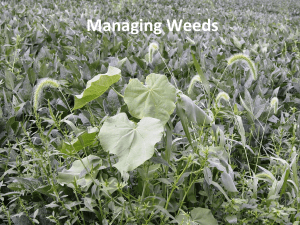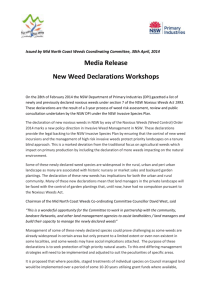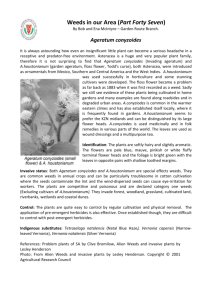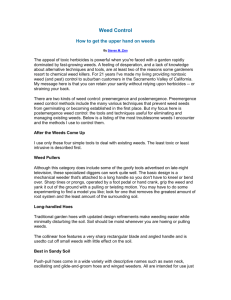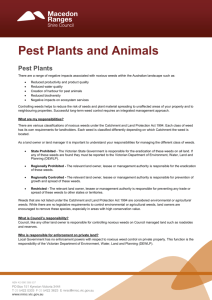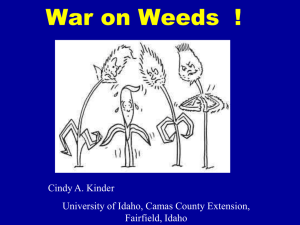Know Your Weeds
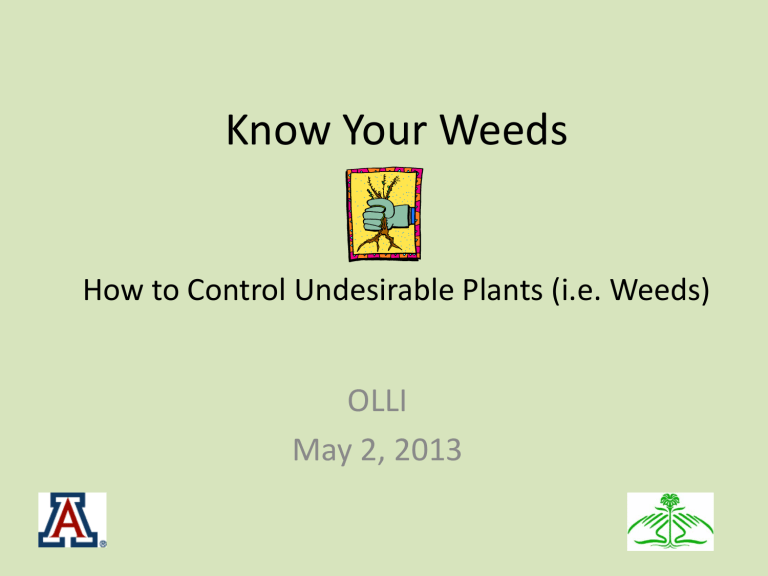
Know Your Weeds
How to Control Undesirable Plants (i.e. Weeds)
OLLI
May 2, 2013
Think it’s a weed?
1. Identify plant
2. Determine biology / life cycle
• Winter annual, summer annual, perennial
3. Determine method(s) of management or leave it and enjoy it
Let’s test your knowledge – can you identify the following
“weeds”?
Pay attention to the biology / life cycle.
Buffalobur
Native summer annual
Filaree (Storksbill)
Introduced winter annual
Puncturevine (Goathead)
Introduced summer annual
Prickly lettuce
Introduced winter or early summer annual
Red stem pigweed
Introduced summer annual
Tumble mustard
Introduced winter or summer annual
Spurge
Introduced summer annual
Ants/spurge relationship
- ants eat caruncles on spurge seeds
- accidently plant them
Russian thistle (tumbleweed)
Introduced summer annual
Locoweed
Native Perennial
Toxic to livestock
Silverleaf nightshade
N ative perennial
Dalmation toadflax
Introduced perennial
Invasive
Field bindweed
Introduced perennial
Squirreltail
Cool season native perennial
Broom snakeweed
Native warm season perennial
Toxic during weed formation
Kochia
Introduced summer annual
Thistles
Smooth stem = native; thorny stem = introduced
Information you should know before you can effectively manage weeds …….
Summer and Winter Annuals
• Summer annual - germinates from seed in spring and early summer; matures in summer; produces seed in fall and dies with first frost
• Winter annual - germinates from late summer through early spring; grows in winter and dies in late spring or early summer when temperature exceeds 85 °
Perennials
Some flourish in cool months and go dormant at onset of summer heat, others grow actively in summer and are suppressed with frost.
Roots can be rhizomes, stolons, fleshy tap roots, corms or tubers.
Management Methods
• Mechanical (pull, mow, till, etc.)
• Cultural (burn, solarize, seed bare ground w/ competitor like cool or warm season grass, or mulch)
• Biological (animals, insects)
• Chemical (herbicides)
Mechanical
Annuals (weeds reproduce from seed)
– Cut before they go to seed.
– If in bloom, cover w/ plastic bag before pulling to keep seeds from spreading.
– Cut (weed eater)or mow before going to seed.
Mowing sometimes ineffective because plants flower too close to soil.
Perennials (grow from roots each year)
– If hand digging, do so when soil is moist; pieces of root often break off and sprout new plants.
Cultural
Solarize to kill seeds and roots in heat of summer (use clear plastic).
Mulch – at least 3” can prevent annuals, not perennials like Bermuda grass.
– Organic: bark, chipped trimmings, wood debris, lawn clippings, compost, etc. Straw not recommended; could have weed seeds.
– Synthetic: landscape cloth, rocks, etc. Plastic not recommended.
Biological
Animals
Chickens, goats, sheep, etc. graze to control weeds.
Insects
Introduced insects can control noxious weeds but will never eradicate; should be done by professionals.
Chemicals
• Pre-emergent herbicides
• Post-emergent herbicides
Pre-emergent Herbicides
• Work best on annual weeds
• Can control perennial species prior to establishment
• Warm season weeds (e.g. tumble weeds) – apply in Spring
• Cool season weeds (e.g. filaree) – apply in Fall
Post-emergent Herbicides
• Selective – only kill targeted weeds –read product label
• Non-selective – kill all vegetation touched by herbicide
Got all that?
There’s more…
Herbicides: Contact and Systemic
• Contact herbicide
– Use on annuals or non-flowering biennials (only kills green tissue contacted by the spray, not the roots)
• Systemic/translocator herbicide
– Use on perennials to kill the root
– Apply when weeds actively growing
– Best when weeds are small
– Does not prevent new weeds
Examples of Ingredients & Products
Ingredients (Product Examples) oryzalin (Weed Stopper) trifluralin (Preen) isoxaben (Gallery)
X
X
X X X
X
X diquat (Zeneca, Weed & Grass Killer) X X dicamba (normally combined w/ others) X X glyphosate (Round-up)
2,4-D (Weed B Gon)
X X
X acetic acid (Burn Out) X ammoniated soap of fatty acids (Natria) X X glufosinate (Finale) X X flauzifop (Grass-B-Gon) X
X X
X
X
X
X X
X X
X X X
X X
X X
X
X X
X
X
X
X
X
X X X
X X
X X
X X
X X X
X
X X
X
What about…..
Corn gluten meal?
– Can work as a pre-emergent on seeds, but it is nitrogen, so timing is critical
Household vinegar?
– Household vinegar is 5% acetic acid & not an approved herbicide; 10% is better for killing weeds
Read Product Labels
• Product may contain more than one herbicide e.g. glyphosate (systemic - slow) & diquat (contact - fast)
• Labels will specify residual impact to soil, but be cautious of run-off, ground water impacts, etc.
• May need stronger application in cooler weather
Caution: chemical sterilents should not be used in residential landscapes
How would you manage -
Russian thistle - summer annual
} -Pre-emergent in spring (before germination)
-Hand pull
-Post-emergent
-Plant more desirable species that compete with weeds
Pull, trash, burn, etc.
Or…
Resources
Plant ID
– Weeds of the West
– Plants of Arizona
– Extension’s Native & Naturalized Plant Database http://cals.arizona.edu/yavapai/yavapaiplants
Herbicide Information
– Read product labels
???



